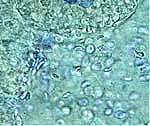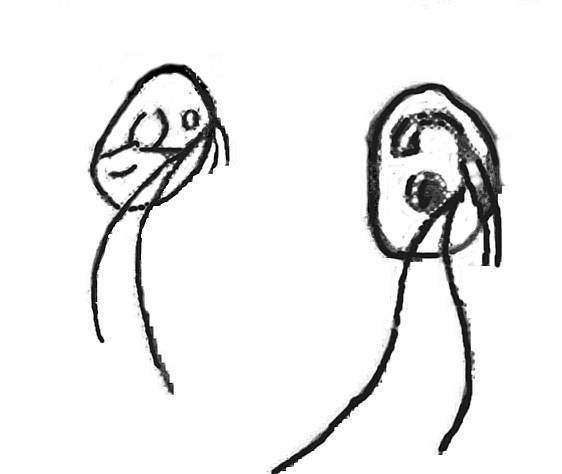ALL THINGS KOI AND H2O
Costia Ichtyobodo
Duncan
Griffiths
Costia Ichtyobodo
is classed as a flagellate
parasite and one of the deadliest, smallest parasites that affect koi and gold
fish, it can also be found on other freshwater and saltwater species of
fish.
Flagellate
parasite can infest fish both externally and internally and are characterised by
one or more Flagella, (hairs).

The
flagella cause a flagellate parasite to move in fashion that is very erratic and
jerk like, Costia Ichtyobodo, is no exception.
Although a
magnification of between x200 to x400 is needed to identify this parasite, its
jerk like and tumbling movements, can clearly be seen as low as x100
magnification, as it gambols and jerks in and out of the field of view under the
microscope, should you witness this spectacle, it should be your first alert to
the possible presence of Costia.
Even though it may still be to small at
this magnification to be seen clearly, no other parasite behaves in this manner.
The two
most common species of Costia are, Ichtyobodo necatrix and Ichtyobodo
pyriformis, with necatrix being by far the most
common.
Both are
extremely small, necatrix being about 20 micron and pyriformis about 15
micron.
Costia has
two pairs of flagella, not one. One of the two pairs is used for propulsion and
attaching itself to the host, the other pair is used in feeding, Costia also has
a macronucleus.
Costia
is pyriform in shape, (pear shaped), although, it only takes on this
shape when physically attached to the host, at all other times it is the shape
of a comma or bean.


The
parasite itself is concave on one side and convex on the other and attaches
itself to the host with a sucker at
one end.
Costia
reproduces by longitudinal fission, and cannot live for more than a couple of
hours without a host, however when conditions are unfavourable to the parasite
they are believed capable of forming into a cyst. Further, in this state they
are also believed to be resilient to being dried out, and will remain in this
state until conditions improve in their favour.
Costia is
also temperature dependant and proliferates between the temperatures of about 10
to 25 deg c and cannot survive at temperatures 28 deg C and above.
Below 10
deg C the parasite will from into a cyst for
protection.
The
parasite is transmitted by direct contact and also is capable of swimming from
host to host in its free swimming form. More importantly it is capable of being
transferred from pond to pond on nets and koi socks.
In very
small numbers costia presents little problem, feeding on sloughed off dead cells
from the host, but in overwhelming numbers it can be responsible for mass
mortalities in koi, by attacking living cells. Costia usually inhabits the gill
and skin and once attached to the host actually destroys tissue at that site,
let me repeat, it destroys tissue! Which is why when found in the gill,
Costia is so devastating, when present in great numbers Costia will destroy gill
tissue rendering the koi weak and debilitated and unable to mount an immune
defence,
Costia is a parasite that is very much an opportunist on weakened
fish, in so much as, when the koi is unwell and cannot mount an immune response.
This allows more of each generation of Costia to survive what is considered
“normal” mortalities of the parasite. Result Costia proliferates and will
steadily multiply, and the end is usually not far
away.
A koi that
is displaying laboured and heavy breathing,off its food, is also lethargic and
covered in excess mucus is showing classic signs of Costia, however a
microscopic examination should be done before commencement of any and all
treatments, also koi suffering from heavy infestation of Costia may not make it
through the treatment regime, as is the case with many parasitic infections.
Every opportunity must taken advantage of to help a debilitated koi whilst
treatments are underway, E.I. good pond hygiene and lots of extra O2,
by means of air stones.
Treatments
Costia can often be found with other parasites that are opportunistic, and may result in treatment modification, e.g. On lots of occasions, Costia is found nestling along side Chilodonella, in such a case the choice of treatment would be malachite green and formalin, you would have to make that decision based on the evidence you have presented at that time.
Treatments are many but the main working treatments are as follows:
Potassium Permanganate, @ 1.5 gm per 220 U.K. Gallons or 265 U.S. Gallons one treatment only, for three to four hours.
Malachite Green and Formalin@
Malachite green 2% 10ml per 176 U.K.gallons
Formalin 30% 10 ml per 150 U.K. gallons
Used both together for one treatment only.
Chloramines T @ 2 gm per 100 U.K gallons
For three treatments only, days one / two and three. Switching off the U.V. light, making sure the ph is above 7.5 as UV light and ph, greatly increase the speed of release into the water of chloramines T and thus alter the toxicity.